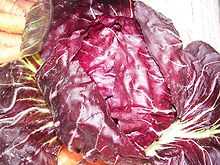Radicchio

| Nutritional value per 100 g (3.5 oz) | |
|---|---|
| Energy | 96 kJ (23 kcal) |
|
4.48 g | |
| Sugars | 0.6 g |
| Dietary fiber | 0.9 g |
|
0.25 g | |
|
1.43 g | |
| Vitamins | |
| Vitamin A equiv. |
8832 μg |
| Thiamine (B1) |
(1%) 0.016 mg |
| Riboflavin (B2) |
(2%) 0.028 mg |
| Niacin (B3) |
(2%) 0.255 mg |
|
(5%) 0.269 mg | |
| Vitamin B6 |
(4%) 0.057 mg |
| Folate (B9) |
(15%) 60 μg |
| Vitamin C |
(10%) 8 mg |
| Vitamin E |
(15%) 2.26 mg |
| Vitamin K |
(243%) 255.2 μg |
| Trace metals | |
| Calcium |
(2%) 19 mg |
| Iron |
(4%) 0.57 mg |
| Magnesium |
(4%) 13 mg |
| Manganese |
(7%) 0.138 mg |
| Phosphorus |
(6%) 40 mg |
| Potassium |
(6%) 302 mg |
| Sodium |
(1%) 22 mg |
| Zinc |
(7%) 0.62 mg |
|
| |
| |
|
Percentages are roughly approximated using US recommendations for adults. Source: USDA Nutrient Database | |
Radicchio (/rəˈdɪkioʊ/ or /rəˈdiːkioʊ/; Italian pronunciation: [raˈdikkjo]) is a leaf chicory (Cichorium intybus, Asteraceae), sometimes known as Italian chicory, and is a perennial. It is grown as a leaf vegetable which usually has white-veined red leaves. It has a bitter and spicy taste, which mellows when it is grilled or roasted.
History
Pliny the Elder claimed radicchio was useful as a blood purifier and an aid for insomniacs in Naturalis Historia. In fact, radicchio contains intybin, a sedative/analgesic, as well as a type of flavonoid called anthocyanin which is used for making dye-sensitized solar cells.
Modern cultivation of the plant began in the fifteenth century, in the Veneto and Trentino regions of Italy, but the deep-red radicchio of today was engineered in 1860 by the Belgian agronomist Francesco Van den Borre, who used a technique called imbianchimento (whitening), preforcing, or blanching to create the dark red, white-veined leaves: radicchio plants are taken from the ground and placed in water in darkened sheds, where lack of light and ensuing inhibition of chlorophyll production cause the plants to lose their green pigmentation.
Varieties
The varieties of radicchio are named after the Italian regions where they originate: the most ubiquitous variety in the United States is radicchio di Chioggia, which is maroon, round, and about the size of a grapefruit.
Radicchio rosso di Treviso resembles a large red Belgian endive.
Other varieties include Tardivo, and the white-colored radicchio di Castelfranco, both of which resemble flowers and are only available in the winter months, as well as Gorizia (also known as "cicoria zuccherina"), Trieste (biondissima) and Witloof/Bruxelles (also known as Belgian endive, and "chicon/endive" in French). Radicchio farmers of the Veneto have sought to have Protected Geographical Status applied to the names of some radicchio varieties including Tardivo.
Culinary arts
In Italian cuisine, it is usually eaten grilled in olive oil, or mixed into dishes such as risotto.
As with all chicories, if grown correctly its roots can be used to mix with coffee.
It can also be served with pasta, in strudel, as a poultry stuffing, or as part of a tapenade.
Toxicity
According to traditional folklore, long-term use of chicory as a coffee substitute may damage human retinal tissue, with dimming of vision over time and other long-term effects. Modern scientific literature contains little or no evidence to support or refute this claim. Root chicory contains volatile oils similar to those found in plants in the related genus Tanacetum which includes Tansy, and is likewise effective at eliminating intestinal worms. All parts of the plant contain these volatile oils, with the majority of the toxic components concentrated in the plant's root.[1]
Studies indicate that ingestion of chicory by farm animals results in reduction of worm burdens, which has prompted its widespread use as a forage supplement. There are only a few major companies active in research, development, and production of chicory varieties and selections. Most of them are in New Zealand.
Cultivation
Radicchio is easy to grow but performs best in spring (USDA Zone 8 and above) and fall (everywhere) gardens. It prefers more frequent but not deep watering, the amount of water varying based on soil type. Infrequent watering will lead to a more bitter tasting leaf. However, for fall crops the flavor is changed predominantly by the onset of cold weather (the colder, the mellower), which also initiates the heading and reddening process in traditional varieties. There are newer, self-heading varieties whose taste is not yet as good as a traditional variety which has matured through several frosts or freezes (e.g., Alouette). Radicchio matures in approximately three months. However, it can be made to stand through a UK or West European winter, and the head will regenerate if cut off carefully above ground level, so long as the plant is protected against severe frost. A light-excluding cover, e.g. an inverted pot, may be used during the latter phases of growth to produce leaves with a more pronounced colour contrast, simultaneously protecting against frost and cold winds. Traditionally in the UK, the first cutting of all chicory heads was simply thrown away, and the tender, forced, second head was for the table. However, improved varieties of radicchio, e.g. Rosso di Verona, and generally milder winters allow the West European cultivator to harvest two or more crops from a single planting. If the head is cut off complete, just above the root, a small, new head will grow, especially if some frost protection is given. This process can be repeated a number of times.
References
- ↑ Edible and Medicinal Plants of the West, Gregory L. Tilford, ISBN 0-87842-359-1
Sources
- http://www.gourmetsleuth.com
- http://www.foodnetwork.com
- http://www.radicchio.com
- http://italianfood.about.com
- http://www.innvista.com/health/foods/vegetables/chicory.htm
- http://www.theworldwidegourmet.com/vegetables/salads/raddichio.htm
- http://www.cuisinenet.com/digest/season/spring/late/veg.shtml
- http://www.jmarchinifarms.com